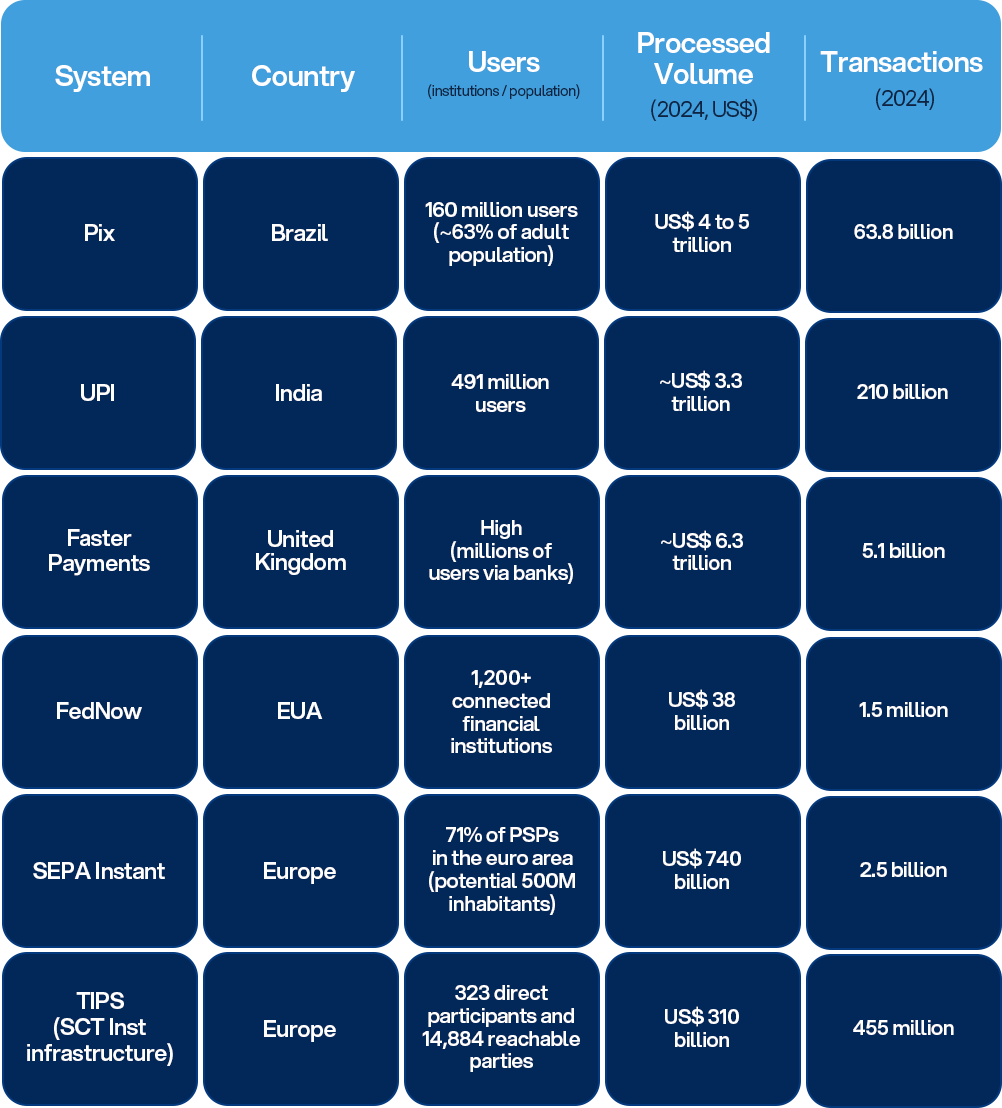Global Trends in Instant Payments: Pix, UPI, FedNow, and Portugal
16 de October de 2025

16 de October de 2025

The digital transformation of payments is reshaping the global financial system. Over 50 countries now operate instant payment systems, and this revolution extends far beyond consumer convenience. We’re witnessing a structural shift that impacts financial inclusion, economic efficiency, and even digital sovereignty.
Brazil, India, the United States, and Europe are each taking different paths on this journey, with unique regulatory frameworks, adoption challenges, and business models. While Brazil’s Pix moved $5 trillion in 2024, India’s UPI processes nearly half of all instant payment transactions worldwide. Meanwhile, the U.S. FedNow is still gaining traction, and Europe is working to unify fragmented markets through Wero and SEPA Instant.
In this article, we compare these four cases, highlighting concrete results, success factors for each model, and practical opportunities for companies looking to integrate instant payments into their operations.
Launched in November 2020 by Brazil’s Central Bank (Banco Central do Brasil), Pix quickly became the country’s preferred payment method. The 2024 figures reveal unprecedented adoption with 160 million users, representing 63% of Brazil’s adult population.
The payment volume is equally impressive. In 2024, Pix moved R$26.45 trillion, equivalent to approximately $4 to $5 trillion USD. There were 63.8 billion transactions throughout the year, solidifying the system as critical infrastructure for Brazil’s financial ecosystem.
The impact on financial inclusion was significant. Before 2020, approximately 34 million Brazilians were unbanked. Pix dramatically reduced that number, enabling users with just a smartphone to access digital payment methods without relying on traditional bank accounts or card readers.
Pix’s strategic advantage lies in its evolution from a simple payment method to a true financial platform. In 2025, three new features marked this transformation.
For businesses, Pix offers concrete competitive advantages. The open API infrastructure facilitates integration with fintechs and corporate systems. Zero fees for individuals and reduced fees for businesses represent significant savings compared to cards and boletos (bank slips).
Real-time settlement directly impacts cash flow, eliminating the D+1 or D+30 delays common with other payment methods. The emerging innovation ecosystem, with features for installments, recurring payments, and collateralization, opens new business model possibilities.
India’s Unified Payments Interface (UPI), created in 2016 by the National Payments Corporation of India (NPCI), has become the world’s largest instant payment system by transaction volume. The numbers are extraordinary, with 491 million users and 65 million merchants connected.
In 2024 and early 2025, UPI processed approximately 185.8 billion transactions, accounting for 83.7% of retail digital payments in India. Payment volume reached approximately $3 to $3.4 trillion USD.
The most striking data point is that UPI represents nearly 50% of all global instant payments by transaction volume. The infrastructure connects 675 banks in a decentralized architecture that ensures resilience and scalability.
Unlike Pix, which is still in the international negotiation phase, UPI already operates cross-border integrations. Since 2023, the system has been connected to Singapore’s PayNow, enabling instant transfers between the two countries.
Integrations with PayPal World are under construction, and several countries are negotiating the adoption of UPI technology. India has transformed UPI into an export product, part of its technological soft power strategy.
UPI democratized digital payments in India, enabling small merchants, street vendors, and informal service providers to accept electronic payments without expensive equipment or sophisticated bank accounts.
The reach extended to rural areas and low-income populations, contributing to economic formalization. The model is free for all users, sustained by a very low Merchant Discount Rate (MDR), which accelerates adoption but raises questions about long-term economic sustainability.
India’s experience demonstrates that mandatory interoperability is fundamental. All banks must participate, eliminating fragmentation. The decentralized architecture ensures no player has monopolistic control, stimulating competition and innovation.
Integration simplicity through QR Codes and open APIs enabled developers to create thousands of applications on top of the UPI infrastructure. For businesses, this means low barriers to entry and high customization potential.
FedNow, launched in July 2023 by the Federal Reserve, is America’s answer to the instant payments revolution. After two years of operation, the system has 1,200 to 1,400 participating financial institutions, significant growth from the initial 900.
However, adoption numbers remain modest compared to Brazil and India. In 2024, FedNow processed only 1.5 million transactions, totaling $38 billion USD. For comparison, Pix processes that volume in a matter of hours.
FedNow faces unique challenges in the American market. Card payment culture is deeply entrenched, with consumers and businesses accustomed to rewards programs, fraud protections, and credit facilities that cards offer.
The fragmentation of the U.S. banking system, with thousands of institutions of varying sizes, makes coordination complex. Unlike Brazil and India, where participation in instant payment systems was mandatory, FedNow operates on a voluntary basis, limiting its reach.
Resistance from incumbents like Visa and Mastercard, which profit billions from the current model, adds political and economic friction to the adoption process.
The Federal Reserve adopted a gradual approach, initially focusing on B2B use cases such as payroll, supplier payments, and corporate transfers. The logic is to demonstrate value in segments where settlement speed directly impacts cash flow.
Partnerships with fintechs and digital banks, which have less inertia than traditional institutions, help build critical mass. Integration with legacy systems like ACH and wire transfers aims to facilitate the transition.
Despite slow retail adoption, FedNow offers significant opportunities for businesses. Cost reduction in corporate transfers can be substantial, especially by eliminating wire transfer fees.
Real-time settlement in supply chain finance improves working capital management. Payroll modernization with on-demand payment (earned wage access) meets growing worker demands. For companies operating cross-border, FedNow may eventually connect to international systems, facilitating global settlement.
Portugal developed its own mobile payment system, MB Way, launched in 2013. It’s a digital wallet integrated with Portugal’s major banks, enabling P2P transfers, retail payments, and even ATM withdrawals.
Penetration is high in Portugal, especially among young and urban populations. However, MB Way remains predominantly domestic, not achieving the pan-European scale necessary to compete globally.
SEPA Instant was launched in 2017 to harmonize instant payments in the euro zone. Currently, 71% of Payment Service Providers (PSPs) participate in the system.
In 2024, SEPA Instant processed $740 billion USD across 2.5 billion transactions. Respectable numbers, but they reveal adoption challenges. In 2023, only 14% of SEPA transfers were instant, showing that most transactions still occur through slower traditional modes.
TARGET Instant Payment Settlement (TIPS), launched in 2018 by the European Central Bank, functions as an instant settlement infrastructure in euros. Technically robust with settlement in under 10 seconds, it connects 323 direct participants and reaches 14,884 reachable parties.
In 2024, it processed €283 billion (approximately $310 billion USD) across 455 million transactions. Despite technical robustness, TIPS faces the challenge of translating capacity into mass practical adoption.
Wero, launched in 2024 by the European Payments Initiative (EPI), represents Europe’s most ambitious attempt to create a pan-European digital wallet based on SEPA Instant.
The rollout is gradual, with Germany in July, France in September, and Belgium in November 2024, with expansion planned for the Netherlands and Luxembourg between 2025 and 2026. The plan includes incorporating services such as e-commerce, BNPL, and credit, aligning with Europe’s digital sovereignty ambition against the dominance of American players (Visa, Mastercard) and Asian players (Alipay, WeChat Pay).
Europe faces unique challenges. Regulatory fragmentation across 27 countries, each with its own laws and banking traditions, makes coordination extremely complex. The gradual rollout contrasts with the massive, simultaneous adoption that Brazil and India achieved through centralized mandates.
The need for coordination among multiple public and private stakeholders, each with its own interests, slows implementation. Europe has the ambition and technical capacity, but struggles against its own institutional diversity.

The table reveals clear patterns. UPI and Pix dominate in absolute transaction volume and market penetration. FedNow, despite the potential of the American market, is still in its infancy. European systems have scale but suffer from fragmented and uneven adoption.
Five critical elements emerge from the comparative analysis.
Brazil and India have proven that emerging markets can lead global financial innovation. The 2024 numbers are clear with 63.8 billion Pix transactions and 185.8 billion UPI transactions, demonstrating mass adoption that developed economies have yet to replicate.
For businesses and financial institutions, five lessons emerge from this analysis. Instant payments are a strategic infrastructure, not just convenience. Proper integration reduces costs and improves cash flow measurably. Open APIs enable innovation on top of public infrastructure. Mandatory interoperability overcomes fragmentation. Ease of use is more important than technical sophistication.
The future points to global interoperability. Connections between national systems will transform cross-border payments into instant and inexpensive transfers. For Brazil, Pix represents a strategic asset with regional expansion potential in Latin America, positioning the country as a global reference in instant payments.
At Luby, we develop technology solutions that help financial institutions and businesses integrate and leverage the full potential of instant payments. From Pix integration APIs to complete financial management platforms, our expertise in financial services ensures security, scalability, and innovation. Learn about our Financial Services solutions